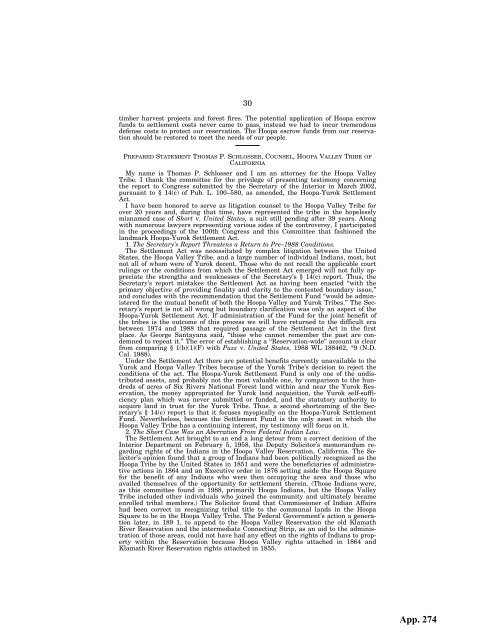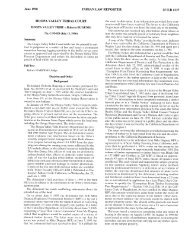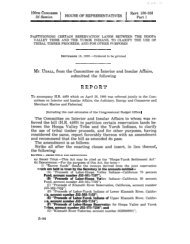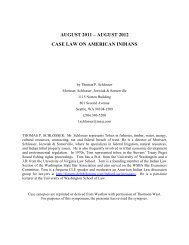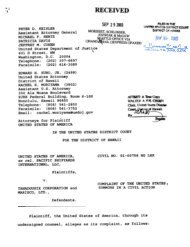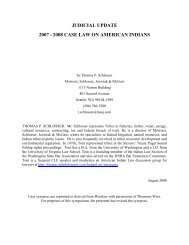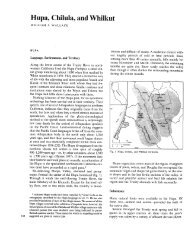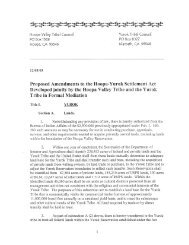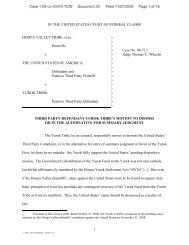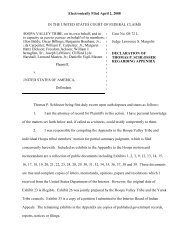Hoopa appendix supporting summary judgment - Schlosser Law Files
Hoopa appendix supporting summary judgment - Schlosser Law Files
Hoopa appendix supporting summary judgment - Schlosser Law Files
You also want an ePaper? Increase the reach of your titles
YUMPU automatically turns print PDFs into web optimized ePapers that Google loves.
30<br />
timber harvest projects and forest fires. The potential application of <strong>Hoopa</strong> escrow<br />
funds to settlement costs never came to pass, instead we had to incur tremendous<br />
defense costs to protect our reservation. The <strong>Hoopa</strong> escrow funds from our reservation<br />
should be restored to meet the needs of our people.<br />
PREPARED STATEMENT THOMAS P. SCHLOSSER, COUNSEL, HOOPA VALLEY TRIBE OF<br />
CALIFORNIA<br />
My name is Thomas P. <strong>Schlosser</strong> and I am an attorney for the <strong>Hoopa</strong> Valley<br />
Tribe. I thank the committee for the privilege of presenting testimony concerning<br />
the report to Congress submitted by the Secretary of the Interior in March 2002,<br />
pursuant to § 14(c) of Pub. L. 100–580, as amended, the <strong>Hoopa</strong>-Yurok Settlement<br />
Act.<br />
I have been honored to serve as litigation counsel to the <strong>Hoopa</strong> Valley Tribe for<br />
over 20 years and, during that time, have represented the tribe in the hopelessly<br />
misnamed case of Short v. United States, a suit still pending after 39 years. Along<br />
with numerous lawyers representing various sides of the controversy, I participated<br />
in the proceedings of the 100th Congress and this Committee that fashioned the<br />
landmark <strong>Hoopa</strong>-Yurok Settlement Act.<br />
1. The Secretary’s Report Threatens a Return to Pre–1988 Conditions.<br />
The Settlement Act was necessitated by complex litigation between the United<br />
States, the <strong>Hoopa</strong> Valley Tribe, and a large number of individual Indians, most, but<br />
not all of whom were of Yurok decent. Those who do not recall the applicable court<br />
rulings or the conditions from which the Settlement Act emerged will not fully appreciate<br />
the strengths and weaknesses of the Secretary’s § 14(c) report. Thus, the<br />
Secretary’s report mistakes the Settlement Act as having been enacted ‘‘with the<br />
primary objective of providing finality and clarity to the contested boundary issue,’’<br />
and concludes with the recommendation that the Settlement Fund ‘‘would be administered<br />
for the mutual benefit of both the <strong>Hoopa</strong> Valley and Yurok Tribes.’’ The Secretary’s<br />
report is not all wrong but boundary clarification was only an aspect of the<br />
<strong>Hoopa</strong>-Yurok Settlement Act. If administration of the Fund for the joint benefit of<br />
the tribes is the outcome of this process we will have returned to the difficult era<br />
between 1974 and 1988 that required passage of the Settlement Act in the first<br />
place. As George Santayana said, ‘‘those who cannot remember the past are condemned<br />
to repeat it.’’ The error of establishing a ‘‘Reservation-wide’’ account is clear<br />
from comparing § 1(b)(1)(F) with Puzz v. United States, 1988 WL 188462, *9 (N.D.<br />
Cal. 1988).<br />
Under the Settlement Act there are potential benefits currently unavailable to the<br />
Yurok and <strong>Hoopa</strong> Valley Tribes because of the Yurok Tribe’s decision to reject the<br />
conditions of the act. The <strong>Hoopa</strong>-Yurok Settlement Fund is only one of the undistributed<br />
assets, and probably not the most valuable one, by comparison to the hundreds<br />
of acres of Six Rivers National Forest land within and near the Yurok Reservation,<br />
the money appropriated for Yurok land acquisition, the Yurok self-sufficiency<br />
plan which was never submitted or funded, and the statutory authority to<br />
acquire land in trust for the Yurok Tribe. Thus. a second shortcoming of the Secretary’s<br />
§ 14(c) report is that it focuses myopically on the <strong>Hoopa</strong>-Yurok Settlement<br />
Fund. Nevertheless, because the Settlement Fund is the only asset in which the<br />
<strong>Hoopa</strong> Valley Tribe has a continuing interest, my testimony will focus on it.<br />
2. The Short Case Was an Aberration From Federal Indian <strong>Law</strong>.<br />
The Settlement Act brought to an end a long detour from a correct decision of the<br />
Interior Department on February 5, 1958, the Deputy Solicitor’s memorandum regarding<br />
rights of the Indians in the <strong>Hoopa</strong> Valley Reservation, California. The Solicitor’s<br />
opinion found that a group of Indians had been politically recognized as the<br />
<strong>Hoopa</strong> Tribe by the United States in 1851 and were the beneficiaries of administrative<br />
actions in 1864 and an Executive order in 1876 setting aside the <strong>Hoopa</strong> Square<br />
for the benefit of any Indians who were then occupying the area and those who<br />
availed themselves of the opportunity for settlement therein. (Those Indians were,<br />
as this committee found in 1988, primarily <strong>Hoopa</strong> Indians, but the <strong>Hoopa</strong> Valley<br />
Tribe included other individuals who joined the community and ultimately became<br />
enrolled tribal members.) The Solicitor found that Commissioner of Indian Affairs<br />
had been correct in recognizing tribal title to the communal lands in the <strong>Hoopa</strong><br />
Square to be in the <strong>Hoopa</strong> Valley Tribe. The Federal Government’s action a generation<br />
later, in 189 1, to append to the <strong>Hoopa</strong> Valley Reservation the old Klamath<br />
River Reservation and the intermediate Connecting Strip, as an aid to the administration<br />
of those areas, could not have had any effect on the rights of Indians to property<br />
within the Reservation because <strong>Hoopa</strong> Valley rights attached in 1864 and<br />
Klamath River Reservation rights attached in 1855.


